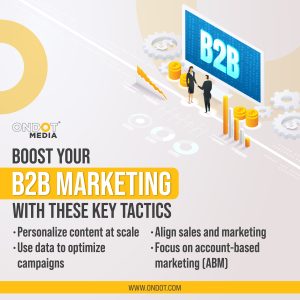LinkedIn has emerged as a powerhouse for B2B marketing, offering businesses the unique ability to engage with industry professionals, decision makers, and potential clients. With over 930 million members globally, the platform provides a prime opportunity for B2B marketers to connect with a highly targeted audience, build brand authority, and generate leads. However, succeeding on LinkedIn requires a thoughtful approach, tailored content, and strategic engagement.
In this blog, we’ll explore best practices for leveraging LinkedIn to maximize your B2B marketing efforts.

Optimize Your Company Page for Credibility and Visibility
Your LinkedIn company page serves as the foundation of your B2B marketing efforts. To make a great first impression and attract your target audience, follow these optimization tips:
Complete Your Profile:
Ensure that your company profile is fully completed with a professional logo, a compelling banner image, and a clear, concise company description. Highlight your brand’s mission, values, and services, making it easy for prospects to understand what you offer.
Use Relevant Keywords:
Optimize your company page for search by incorporating relevant industry keywords in the company description, specialties, and even the tagline. This will help improve visibility in LinkedIn searches and Google results.
Showcase Products & Services:
Use the ‘Featured’ section or individual posts to highlight your top products and services. Include case studies, testimonials, and success stories to build trust and demonstrate value.
Add a Call-to-Action (CTA):
Encourage visitors to take the next step by adding CTAs like “Visit our website,” “Learn more,” or “Get in touch” in your posts or company profile summary.
Share Valuable, Industry Focused Content
Content is the key to engagement on LinkedIn, but it’s important to remember that LinkedIn is a professional platform. Your content should reflect your industry expertise and offer value to your B2B audience.
Post Regularly:
Consistent posting is critical to maintaining visibility. Aim to post at least two or three times a week to stay on your audience’s radar.
Use Thought Leadership:
Establish your company as a thought leader by sharing insights, industry trends, and expert opinions. Longform content like articles and posts can showcase your deep understanding of industry challenges and solutions.
Mix Content Formats:
Experiment with a variety of content formats, such as videos, infographics, slideshows, polls, and articles. Multimedia content tends to get higher engagement, and LinkedIn’s algorithm favors content that users spend time interacting with.
Leverage Case Studies & White Papers:
Share in-depth case studies and research that highlight your expertise in solving industry specific problems. White papers, reports, and eBooks that offer actionable insights will resonate with B2B audiences looking for reliable solutions.
Engage with Timely Content:
Participate in conversations around current events, industry news, and trends. Use relevant hashtags and contribute to trending discussions to increase visibility and position your company as relevant to ongoing developments.
Engage with Your Audience Through Interaction
Engagement is the driving force behind building relationships on LinkedIn. It’s not enough to post content. You must actively engage with your audience to foster connection and trust. Here is how to drive healthy and active engagement:
Respond to Comments:
Take the time to respond to comments on your posts, acknowledging feedback and sparking conversations. This helps humanize your brand and encourages further engagement.
Join LinkedIn Groups:
Participate in relevant LinkedIn groups where your target audience is active. Engage in meaningful discussions, answer questions, and offer valuable insights to position yourself as a trusted industry voice.
Use Polls to Generate Engagement:
Polls are an excellent way to generate engagement and gather insights from your audience. Use polls to ask questions about industry trends, challenges, or preferences, and use the results to inform your future content strategy.
Personalize Outreach:
When connecting with new prospects or leads, always send personalized connection requests. A brief, thoughtful message explaining why you’d like to connect goes a long way in establishing rapport.
Also read: Top 6 B2B Event Marketing Strategies
Leverage LinkedIn Ads for Targeted Outreach
While organic reach is valuable, LinkedIn’s paid advertising platform offers a powerful way to target specific B2B audiences based on industry, job title, company size, and more. Here’s how to use LinkedIn ads effectively:
Define Your Audience:
The strength of LinkedIn’s ad platform lies in its precise targeting options. You can target users based on their company size, industry, job title, location, and even professional skills. This makes it easy to focus on decision-makers and key stakeholders within your target market.
Choose the Right Ad Format:
LinkedIn offers a variety of ad formats, including Sponsored Content, Message Ads, and Dynamic Ads. Sponsored Content (native ads) tends to work well for promoting thought leadership content, case studies, or driving traffic to your website. Message Ads are ideal for direct outreach with personalized offers or invitations.
Test and Optimize Campaigns:
Regularly monitor your ad performance and tweak your campaigns based on key metrics like click-through rates (CTR), cost-per-click (CPC), and conversion rates. A/B testing different headlines, visuals, and CTAs can help you refine your approach and maximize ROI.
Use LinkedIn Analytics to Measure Success
Tracking and analyzing your LinkedIn performance is critical for understanding what works and where improvements are needed. Use LinkedIn’s built-in analytics tools to monitor:
Engagement Metrics:
Track likes, comments, shares, and clicks on your posts to understand what content resonates best with your audience.
Follower Growth:
Keep an eye on your follower count and note any spikes or declines. These fluctuations often correlate with specific content or campaigns.
Conversion Tracking:
For LinkedIn ads, use conversion tracking to measure how many leads or actions resulted from your campaigns. This helps you calculate the ROI of your LinkedIn advertising efforts.
Conclusion
LinkedIn offers an unparalleled platform for B2B marketers to reach decision makers, build authority, and generate qualified leads. By optimizing your company page, sharing valuable content, engaging with your audience, leveraging paid ads, and tracking performance, you can create a robust LinkedIn strategy that drives business growth. Start implementing these best practices today to unlock the full potential of LinkedIn for your B2B marketing efforts.

Add a Comment